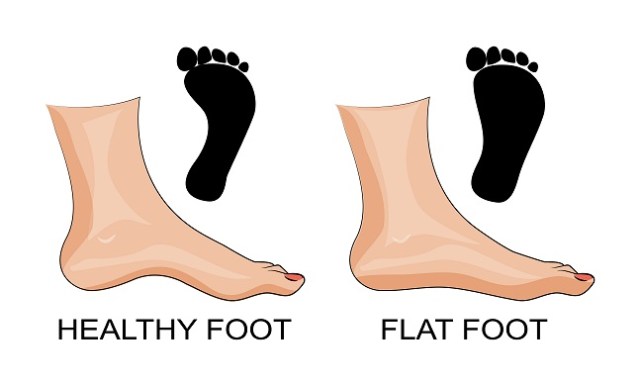Flat Foot
What is flat foot?
Flat foot, also known as pea planus is a deformity which is characterized by the absence of arch in the feet or a very low arch in the feet. Due to this, the entire soul of the affected person’s feet tend to touch the ground on standing. It is a painful condition which develops when the arches of your feet do not develop in childhood or gets worn due to age or injury. The condition may even be present at the time of birth itself.
Flat foot in children and adolescents
Flat foot in both children and adolescents can be classified into-
Flexible flat-foot
Flexible pes valgus appears in toddlers as a normal stage in development, and it usually disappears between 4 and 10 years of age, when medial arch development occurs; occasionally, though, it persists into adult life. The arch can often be restored by simply dorsiflexing the great toe (Jack’s test) and during this manoeuvre, the tibia rotates externally. Many of these children have ligamentous laxity and there may be a family history of both flat feet and joint hypermobility.
Stiff (or ‘rigid’) flat foot
A deformity that cannot be corrected passively should alert the examiner to an underlying abnormality. In older children, conditions to be considered are:
(1) Tarsal coalition; (2) an inflammatory joint disorder; and (3) a neurological disorder.
Compensatory flat foot
This is a spurious deformity that occurs in order to accommodate some other postural defect. For example, a tight tendo Achillis (or a mild fixed equinus) may be accommodated by averting the foot; or if the lower limbs are externally rotated the body weight falls anteromedial to ankle and the feet go into valgus-the Charlie Chaplin look.
Symptoms
People with flat feet usually have no symptoms. However, some people may experience foot pain in the heal or arch area. This pain tends to worsen with activity. There may be swelling along the inside of the ankle. Due to instability of the posture in some people, hip, knee and lower back pain may also occur. The inadequate distribution of weight in people suffering from flat foot makes their shoes wear out faster than usual and in an uneven manner.
Causes of flat foot
The primary causes of flat foot involve-
- Genetic factors
- Foot or ankle injury
- Arthritis or rheumatoid arthritis
- Foot arch doesn’t develop
- Wear and tear of arches as a person age
Treatment
Physiological flat foot
Young children with flexible flat feet require no treatment. Parents need to be reassured of its normality and told that the foot posture will usually correct itself between the ages of 5 and 10 years. If by then it does not fully correct, the foot will remain flat but function is unlikely to be impaired. Some parents will cite examples of other children who were helped by insoles or moulded heel-cups. These appliances may reduce symptoms and serve mainly to alter the pattern of weight bearing and hence that of shoes wear but do not influence foot growth; simply put, they are more effective in treating the shoes than the feet. There is no scientific evidence that any shoe, insole or orthotic influences foot growth; to the contrary there are longitudinal studies that show no change in a treated group of children with flat evidence to suggest that shoes may inhibit natural development of the longitudinal arch of the foot.
Tight tendo Achilles
Flat foot associated with a short tendo achilles (FFF-STA) and restricted dorsiflexion at the ankle may benefit from tendon-stretching exercises and should be encouraged.
Accessory navicular
This occurs in approximately 10% of feet and is usually asymptomatic. Sometimes the main complaint (with a flexible flat foot) is tenderness over a usually prominent navicular on the medial border of the midfoot. X-rays may show an extra ossicle at this site.

